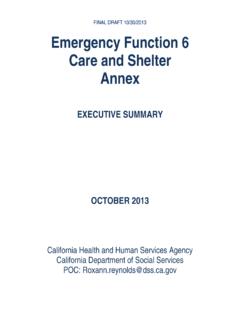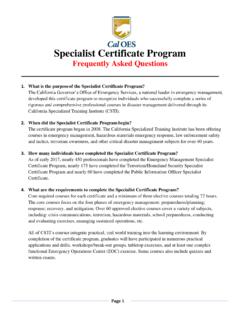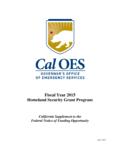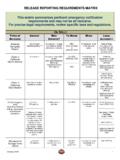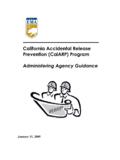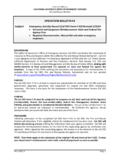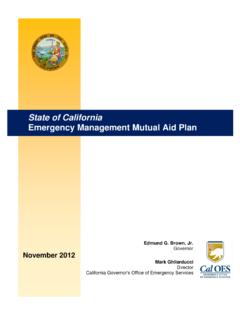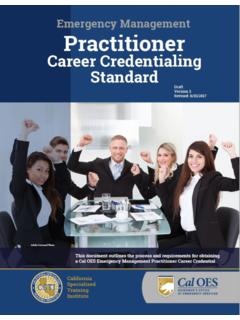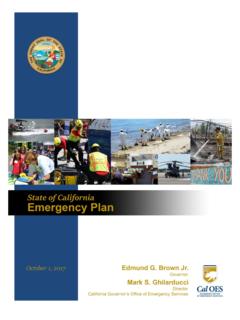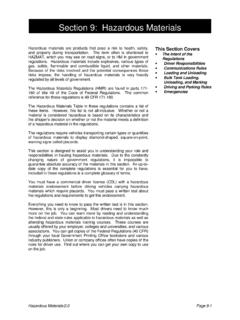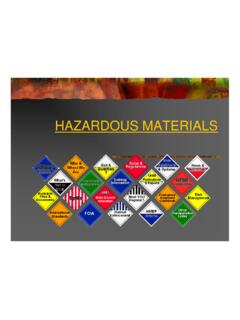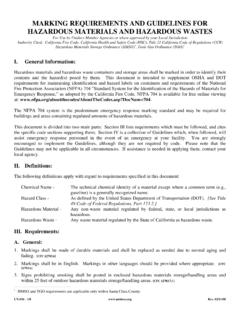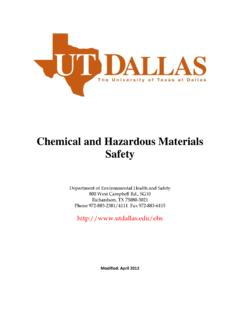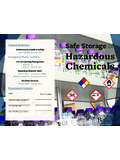Transcription of California Hazardous Materials Spill / Release ...
1 California Hazardous Materials Spill / Release Notification Guidance To Report all significant releases or threat- ened releases of Hazardous Materials : First Call: 9-1-1. (or local emergency response agency). Then Call: Cal OES State Warning Center (800) 852 - 7550 or (916) 845 - 8911. February 2014. Edmund G. Brown Jr., Governor Mark S. Ghilarducci, Director Revised by: Trevor Anderson, Bill Potter & Jon Kolman Layout by: Jon Kolman February 2014. This guidance summarizes pertinent emergency notification requirements. For precise legal requirements, review specific laws and regulations. This guidance applies to all significant re- leases of Hazardous Materials . Refer to the Safe Drinking Water Act of 1986, better known as Proposition 65, and 9030 of the California Labor Code for additional reporting requirements.
2 The State of California makes no warranty, expressed or im- plied, and assumes no liability for omissions or errors con- tained in this publication. Spill OR Release NOTIFICATION. Q: What are the emergency notification requirements in case of a Spill or Release of Hazardous Materials ? A: All significant releases or threatened releases of a Hazardous material , including oil and radioactive Materials , require emer- gency notification to government agencies. The law specifies: Who must notify What information is needed Which government agencies must be notified When must government agencies be notified Release quantity or basis for the report WHO MUST NOTIFY. Q: Who is obligated to notify? A: Requirements for immediate notification of all significant spills or threatened releases cover: Owners Operators Licensees Persons in Charge Employers Notification is required regarding significant releases from: Facilities Vehicles Vessels Pipelines Railroads State law: Handlers, any employees, authorized representa- tives, agent or designees of handlers shall, upon discovery, im- mediately report any Release or threatened Release of Hazardous Materials (Health and Safety Code 25510).
3 Federal law: Notification to the National Response Center is required for all releases that equal or exceed federal reporting quantities: (EPCRA) Owners and Operators to report, and (CERCLA) Person in Charge to report 3. WHEN TO NOTIFY. Q: When must emergency notification be made? A: All significant spills or threatened releases of Hazardous Materials , including oil and radioactive Materials , must be im- mediately reported. Notification shall be made by telephone. Also, written Follow-Up Reports (Section 304) are required within 7 days if the Release equals or exceeds the Federal Re- portable Quantities. (see web site for more information). WHAT INFORMATION. Q: What information is required? A: State notification requirements for a Spill or threatened Release include (as a minimum): Identity of caller Exact location, date and time of Spill , Release or threatened Release Location of threatened or involved waterway or stormdrains Substance, quantity involved, and isotope if necessary Chemical name (if known, it should be reported if the chemical is extremely Hazardous ).
4 Description of what happened Federal notification required additional information for spills (CERCLA chemicals) that exceed federal reporting require- ments, which includes: Medium or media impacted by the Release Time and duration of the Release Proper precautions to take Known or anticipated health risks Name and phone number for more information 4. WHICH AGENCIES. Q: Who must be notified? A: Notification must be given to the following agencies: The Local Emergency Response Agency 9-1-1 or the local Fire Department The Local Unified Program Agency (UPA), if different from local fire. Note: The UPA may designate a call to the 9-1-1 emergency number as meeting the requirement for notifying the UPA. Phone:_____. enter local number And The California Governor's Office of Emergen- cy Services, California State Warning Center: Phone (800) 852-7550 or (916) 845-8911.
5 And, if appropriate: The California Highway Patrol: Phone: 9-1-1. (The California Highway Patrol must be notified for spills oc- curing on highways in the State of California . (CVC )). 5. In Addition, as necessary, one or more of the following: National Response Center If the Spill equals or exceeds CERCLA Federal Report- able Quantities, Phone: (800) 424-8802. United States Coast Guard Waterway Spill / Release Sectors: San Francisco: (415) 399-3547. Los Angeles/Long Beach: (310) 521-3805. San Diego: (619) 278-7033. California Occupational Safety and Health Administra- tion (Cal/OSHA). For serious injuries or harmful exposures to workers, contact the local Cal/OSHA District Office California Department of Health Services, Radiological Health Branch All radiological incidents, contact the California State Warning Center Department of Toxic Substances Control (DTSC).
6 Hazardous waste tank system releases, and secondary containment containment releases, contact the appropri- ate DTSC Regional Office Department of Conservation Division of Oil, Gas, and Geothermal Resources (DOG GR) Release of Oil and Gas at a Drilling and Production Facility, contact the appropriate DOGGR Office Public Utilities Natural Gas Pipeline Releases, contact the Public Utilities Commission (PUC). Department of Fish and Wildlife, Office of Spill Preven- tion and Response (DFW). Waterway Spill / Release , contact the appropriate DFW Office or the California State Warning Center Regional Water Quality Control Board (RWQCB). Waterway Spill / Release , contact the appropriate RWQCB Office 6. Notification must also be made to the California Governor's Office of Emergency Services, California State Warning Center for the following: Discharges or threatened discharges of oil in marine waters Any Spill or other Release of one barrel (42 gallons) or more of petroleum products at a tank facility Discharges of any Hazardous substances or sewage, into or on any waters of the state Discharges that may threaten or impact water quality Any found or lost radioactive Materials Discharges of oil or petroleum products, into or on any waters of the state Hazardous Liquid Pipeline releases and every rupture, explosion or fire involving a pipeline WRITTEN REPORTS.
7 Q: When are written reports required? A: Different laws have different time requirements and cri- teria for submitting written reports. After a Spill or Release of Hazardous Materials , including oil and radioactive Materials , immediate verbal emergency notification should be followed up as soon as possible with a Written Follow-Up Report, if required, to the following agencies: 1) California Governor's Office of Emergency Services Section 304 Follow Up Report. 2) The responsible regulating agency such as: California Department of Health Services, Radiological Health Branch, Radiological Incident Reporting. Department of Toxic Substances Control, Facility Incident or Tank System Release Report. Cal/OSHA, serious injury or harmful exposure to workers.
8 3) DOT and DOE, transportation-related incidents. 7. PENALTIES. Federal and state laws provide for administrative penalties of up to $25,000 per day for each violation of emergency notifica- tion requirements. Criminal penalties may also apply. STATUTES. Q: What statutory provisions require emergency notification? A: Many statutes require emergency notification of a hazard- ous chemical Release , including: Health and Safety Code , 25510. Vehicle Code Public Utilities Code 7673 (General Orders #22-B, 161). Government Code 51018, (a). Water Code 13271, 13272. California Labor Code (b). Title 42, Code 9603, 11004. Q: What are the statutory provisions for written Follow-Up Reports (Section 304)? A: Written reports are required by several statutes, including: Health and Safety Code 25503 (c) (9).
9 California Labor Code (a). Water Code 13260, 13267. Title 42, Code 11004. Government Code 51018. REGULATIONS. In addition to statutes, several agencies have notification or reporting regulations: Title 8, CCR, 342. Title 13, CCR, 1166. Title 14, CCR, 1722 (h). Title 17, CCR, 30295. Title 19, CCR, 2703, 2705. Title 22, CCR, (j), (e). Title 23, CCR, 2230, 2250, 2251, 2260. Title 40, CFR, 263 esp. Section Title 49, CFR, 8. WEBSITES. State Regulations State Statutes Federal Regulations Federal Reportable Quantities See California Labor Code 9030 and the Safe Drinking Water and Toxic Enforcement Act of 1986 (Proposition 65) for other reporting requirements. DEFINITIONS. Q: What is a Hazardous material ? A: Any material that, because of its quantity, concentration, or physical or chemical characteristics, poses a significant present or threatened hazard to human health and safety or to the environment, if released into the workplace or the environ- (Health and Safety Code, 25501 (m)).
10 Q: What is a Release ? A: Any spilling, leaking, pumping, pouring, emitting, empty- ing, discharging, injecting, escaping, leaching, dumping, or dis- posing into the environment, unless permitted or authorized by a regulatory agency . (Health and Safety Code, 25501 (q) and CERCLA 101 (22)). Q: What is a threatened Release ? A: A threatened Release is a condition creating a substantial probability of harm that requires immediate action to prevent, reduce, or mitigate damages to persons, property, or the envi- ronment. (Health and Safety Code 25501 (u)). 9. Q: What Hazardous material Release requires notification? A: All significant spills, releases, or threatened releases of haz- ardous Materials must be immediately reported. In addition, all releases that result in injuries, or workers harm- fully exposed, must be immediately reported to Cal/OSHA.
